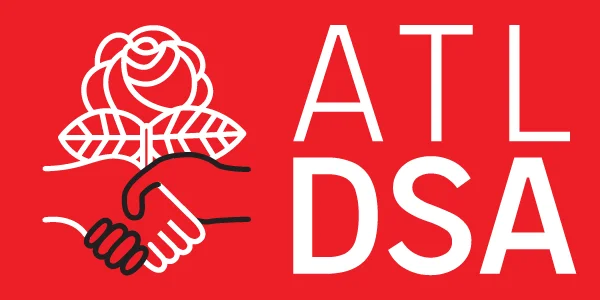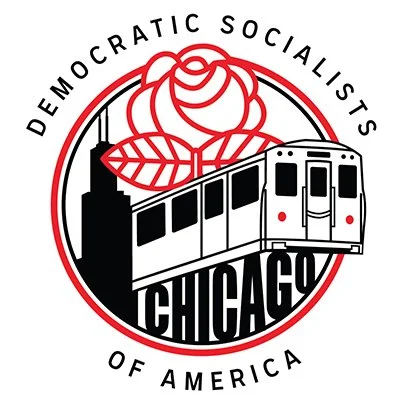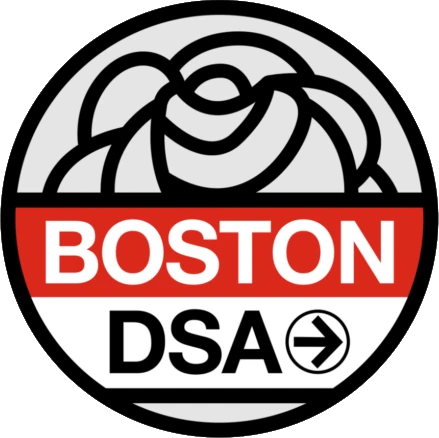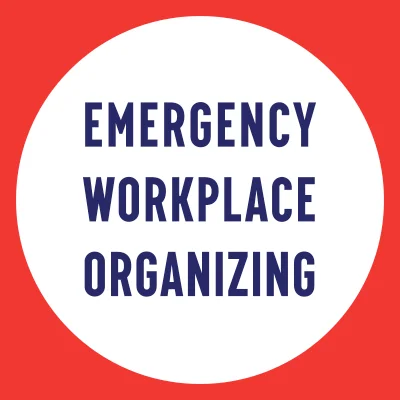
Welcome to the DSA Feed
This is a feed aggregator that collects news and updates from DSA chapters, national working groups and committees, and our publications all in one convenient place. Updated every day at 8AM, 12PM, 4PM, and 8AM UTC.


Atlanta DSA endorses Gabriel Sanchez for State House
Atlanta DSA is proud to once again endorse our comrade Gabriel Sanchez for re-election to the Georgia State House, representing District 42.
In 2024, we made history by electing Representative Sanchez, the first Democratic Socialist in Georgia’s State House, on a platform of housing, healthcare, and an economy that works for all of us. Now, he’s running for re-election in 2026 to continue to fight for working families, stand up to fascism, and build a better Georgia for all. Atlanta DSA is thrilled to back our comrade once again.
Gabriel has been an active member of Atlanta DSA since 2019 and has spent years supporting striking workers on picket lines, organizing to Stop Cop City, campaigning for abortion rights, and advocating for a Free Palestine. During his first term, Gabriel continued fighting for working Georgians in the State House with support from a staff made up of DSA members. He introduced bills to raise the minimum wage to $20 and end corporate ownership of Georgia homes, voted to eliminate subminimum wages for disabled workers and against tax cuts for the wealthy, and authored and held a hearing for a bill to end rental price fixing via AI software. Gabriel also brought his many years of experience as a community organizer into his first term. Over the past year, he has hosted in-district mutual aid events in partnership with Atlanta DSA, as well as town halls and meet and greets to speak directly with residents about the pressing issues they’re facing right now. Our chapter is extremely proud of the work Representative Sanchez has done, and we look forward to continuing to build a Georgia for all alongside him.
As a proud Democratic Socialist, Gabriel is refusing money from corporations or their PACs. Just like last time, we’re running a grassroots campaign of, by, and for working people, and we need your help to win this election. Donate now at SanchezForGeorgia.com
In the lead-up to the 2024 election, Atlanta DSA knocked thousands of doors in District 42 to talk directly to voters about Gabriel’s campaign for housing, healthcare, and an economy for all. We’re planning to do the same next year. Sign up now to volunteer with our campaign at atldsa.org/Volunteer4Gabriel and stay tuned for info about a kickoff canvass in the new year. Let’s re-elect Representative Gabriel Sanchez! 


GRDSA for the Many – We support money out of politics, funding education, and rank choice voting!
There are several ballot initiatives circulating petitions this cycle. The members of the GRDSA are proud to endorse Invest in MI Kids, MOP Up Michigan, and Rank MI Vote. If successful, these initiatives would mean real change for Michiganders.
We are circulating petitions! Our goal is to contribute 1,000 collected signatures for the Invest in MI Kids and MOP Up Michigan campaigns. If you are interested in volunteering, please fill out this form.

Invest in MI Kids – investinmikids.org
We support this ballot initiative because every student deserves access to excellent public education. This excellence requires proper facilities, educational material, and well-paid teachers. To fund these vital elements of education, this initiative would create a 5% fair share surcharge on income over $500K ($1M filing jointly) to be deposited in the State School Aid Fund. It will also add a requirement that money from the School Aid Fund be spent exclusively on local school districts.
MOP Up Michigan – mopupmichigan.org
MOP = Money Out of Politics
We deserve fair utilities, a clean environment, and honest elections. But as our bills continue to grow, utility companies use political contributions to avoid accountability and slow down reform. This ballot initiative would reign in corporate control of government by prohibiting companies with over $250,000 in government contracts from making campaign contributions. Additionally, the initiative introduces finance laws which would require donor information to be made more clear in political communications.
Rank MI Vote – rankmivote.org
NOTE: The Rank MI Vote campaign has suspended signature gathering for their 2026 statewide campaign.
We believe every voter should feel comfortable voting for their best option, rather than the better of two bad options. Rank choice voting is an alternative voting system where the voter ranks up to five candidates for each office, as opposed to picking one option. This allows the voter to rank their favorite candidate first, even if they aren’t likely to win, before ranking their second, third, etc. Voters may still vote for just one candidate or leave that office/section blank. If the votes are tallied and no candidate has enough votes to win, candidates with less votes are eliminated and back up choices are used until one candidate wins.
Dishonorable Mention
There are a few bad petitions circulating as well. There are some that would require IDs to vote and one to cut taxes, Ax MI Tax. Decline to sign these regressive initiatives.
The post GRDSA for the Many – We support money out of politics, funding education, and rank choice voting! appeared first on Grand Rapids Democratic Socialists of America.


The Vermont Socialist (12/7/25): The belated November edition
Happy belated Thanksgiving, and apologies for the tardy newsletter. Remember that it’s now flu season, so make sure that your immunizations are up to date (or you too might fall behind on your work!).
The legislative season is around the corner, and legislators are dealing with the fallout from federal budget cuts, with which come an intensification of the ever-present calls for austerity. This year, some of our most vulnerable friends and neighbors were thrown on the street and left without food. GMDSA believes not just that everyone deserves housing and food, but that the money exists — what we need is the political will. That’s why GMDSA’s second annual convention voted to make Tax the Rich our priority campaign for 2026.
Our members also voted on a new slate of officers and committee chairs. Congratulations in particular to Will Fritch, our new East Branch Co-Chair, and Nana Brownell, who will be returning to that same role for West Branch.
Upcoming Events
GMDSA is sponsoring “For Ukrainian Self-Determination: Building International Working Class Solidarity,” featuring our very own Sen. Tanya Vyhovsky and Traven Leyshon. Discussion begins December 15th at 5pm at Migrant Justice (179 S. Winooski Ave., Burlington) .
Talk about your job and learn about shop-floor organizing from peers at Workers' Circle (co-hosted by the Green Mountain IWW) on the second and fourth Wednesdays of each month. The next one is at 6pm and is also at Migrant Justice on December 10th.
GMDSA Meetings
Labor Committee meets December 8 at 6pm
Membership Committee meets December 8 at 7pm
Electoral Committee meets December 9 at 6pm
Communications Committee meets December
General Meeting on December 20th (details TBA; check our calendar)
TState News
Burlington’s democratic, member-run, GMDSA-sponsored cinema is now open for business. Congrats to Partizanfilm on its successful opening!


Grassroots Red-Greens
World leaders continue to show the necessity for the development of ecosocialism at the local level. Faced with capitalist ecocide, ecosocialism demands ecological balance. As noted by Anti*Capitalist Resistance, environmental issues are not luxury concerns, because the same people polluting the planet are the people oppressing the working class. The fight against capitalism’s waste and inequity must begin locally and spread internationally.
One example of an international shortcoming is the November 2025 United Nations Climate Change Conference (also known as COP30, the 30th meeting of the Conference of the Parties, in Belém, Brazil) ending without an agreement on phasing out fossil fuels. This is not surprising, considering COP30 had around 1,600 attendees who were fossil fuel lobbyists, outnumbering every national delegation other than Brazil. This is in addition to the voices of petrostate attendees like Russia and Saudi Arabia and the absence of the United States, one of the world’s largest emitters of greenhouse gas, which did not send a delegation. A group of U.S. leaders did attend in an unofficial capacity, however, and they discussed how U.S. cities and states are addressing the climate crisis.
Although absent from COP30 and with leadership that increasingly rejects climate science, the U.S. is experiencing the devastating effects of climate change. Across all regions of the United States, people are experiencing warming temperatures and extreme weather conditions, including flooding, wildfires, and hurricanes. Low-income areas and communities of color disproportionately feel these effects.
But there are economic costs, too, as the first half of 2025 was the costliest on record for major disasters in the U.S., totaling over $100 billion. The United States will continue to face direct and compounding challenges as average surface temperatures continue to rise.
For the above reasons and many others, the journey to national (and, eventually, worldwide) ecosocialism must begin locally. Localities, particularly cities like Chicago, have the potential to successfully implement ecosocialist goals. These goals include efficient and universally accessible public transportation, local food sovereignty, and the elimination of fossil fuels.
The work the Fix the CTA campaign has been doing will strengthen Chicago’s public transportation system. If Zohran Mamdani achieves his goal of free public buses in New York City, such an accomplishment can serve as a model for Chicago and other municipalities. New York City’s congestion pricing should also be a model for municipalities, as the corollary for free and efficient public transportation is the reduction of private vehicles.
Despite inequities and reliance on multinational corporations, Chicago can accomplish local food sovereignty through, among other things, greater support for local growers and kitchens.
New York’s Build Public Renewables Act, which authorizes state-owned clean energy projects, is an example of favorable decarbonization that resulted from years of organizing by DSA. Although New York is unique in that it has the nation’s largest public energy provider, passage of the Build Public Renewables Act shows that grassroots organizing works. People in every jurisdiction can organize for clean energy sources like solar power.
On a daily basis, people in every jurisdiction can recycle and use other sustainability efforts to minimize our own ecological footprint. Reusing items also serves the dual purpose of minimizing the flow of money from corporations to dangerous regimes.
Of course, the final boss of ecosocialism is capitalism as a whole. Ecological balance is inconsistent with capitalism’s profit maximization that commodifies both people and nature. In that vein, ecosocialism requires a widespread and revolutionary social transformation and collectivization of the means of production. But the roots for ecosocialism are planted at home.
The post Grassroots Red-Greens appeared first on Midwest Socialist.


The Starbucks Strike and the Long Memory of the Kitchen

[[{“value”:”

By: Carlos B
The modern figure of the chef did not begin in a luxury dining room. It began in the barracks, in hunger, in political upheaval. Marie-Antoine Carême—the man later called the “King of Chefs and Chef of Kings”—was born in 1784 to an unemployed laborer on the outskirts of Paris. He was one of eight children. His father, overwhelmed by poverty as the French Revolution unfolded, took him in the city at the age of ten with a single instruction: find work and survive.
Carême did. He washed dishes, swept floors, and cooked in exchange for food for his 8 brothers. He was a worker before he was an artist. He lived in the same uncertainty as the masons and stonecutters who built Paris. From them he absorbed a way of seeing structure, symmetry, order. And in the heat of revolutionary France, surrounded by ruins and construction sites, he began shaping pastry as if it were stone—edible monuments that echoed the geometric clarity of the nation’s new architecture.
His pièces montées—towering sculptures of sugar, dough, and caramel—borrowed from the building language that would later inspire Le Corbusier and the architects that remade modern France. Carême believed that architecture and cuisine were parallel disciplines: both required discipline, engineering, creativity, and respect for labor. He designed not only dishes, but the first chef’s jacket—white, double-breasted, practical, proudly worn by cooks to this day. A uniform built for workers.
Nearly a century later, during the upheavals of the 1930s, another chapter of kitchen history unfolded—not in Paris, but in Minneapolis. The Great Depression crushed wages and pushed millions toward starvation. In 1934, as the city’s Teamsters strike escalated, workers built a commissary to feed thousands of strikers, supporters, and families. It was not a restaurant. It was a lifeline: a kitchen to keep people warm, sheltered, nourished, and alive. A place where food was not a commodity but a collective defense. In the middle of police beatings and freezing nights, workers cooked vats of stew, baked bread, treated injuries, and protected each other. The commissary became an engine of solidarity.
This is a pattern in American labor history. When a crisis arrives, kitchens appear. They appear because eating every day is a fundamental human need, and because the ability to feed each other is one of the oldest acts of resistance. The soup lines of the 1930s, the civil rights kitchens of the 1960s, the mutual-aid networks after hurricanes and pandemics—all extend the same lineage that began with Carême the child laborer building pastry monuments for a nation under reconstruction.
And today across Austin, Buffalo, Philadelphia, Washington, Chicago, New York City, Providence, Boston, Minneapolis and more, volunteer cooks and labor activists assemble meals for the Starbucks strikers.
Dozens of cooks, friends and supporters of the Starbucks workers participated in elaborating meals for the picket lines. Several menus came together based on the proposal of cooking foods from Palestina, South America, Vietnam as well as traditional midwestern comfort food in memory of the 1934 teamsters strike, where the kitchen commissariat started.
These solidarity kitchens are not charity. They are infrastructure—built by food workers, baristas, cooks, organizers, and community members who understand that the fight for wages, safety, and dignity runs through the stomach as surely as through the picket line.
At this moment, the national Starbucks strike honors that tradition. The young baristas are stepping into the long memory of labor in the United States. They are showing that the struggle for better conditions is never just about pay.
From Antoine Carême shaping pastry like architecture, to the Minneapolis commissary nourishing an entire strike in 1934, to today’s kitchens supporting Starbucks workers—the lesson is the same: food is a collective act of dignity.
Let’s help them win.
Carlos B is a chef and organizer of the Starbucks worker solidarity kitchens.
The post The Starbucks Strike and the Long Memory of the Kitchen appeared first on Working Mass.
“}]]

Your National Political Committee Newsletter — Bringing the Light
Enjoy your December National Political Committee (NPC) newsletter! Our NPC is an elected 27-person body (including both YDSA Co-Chairs) which functions as the board of directors of DSA. This month, check out hot labor solidarity across the country, sign up for volunteer opportunities for the New Year, and more!
And to make sure you get our newsletters in your inbox, sign up here! Each one features action alerts, upcoming events, political education, and more.
- From the National Political Committee — Bringing the Light
- Workers Demand More Forever Program Committee — Apply by Friday 1/9/26
- DSA Archive Volunteer Opportunity — Deadline Saturday 1/10/26
- Be Part of the DSA National Editorial Board! Apply by Thursday 1/15/26
From the National Political Committee — Bringing the Light
Dear Comrades,
Cultures around the world have found ways to celebrate the time around the winter solstice, using candles and lights to cut through the early darkness, and celebrations and rituals to combat the isolation and sadness that comes with the winter’s chill.
As socialists, this is a time to pause and remember what we are fighting for; to look past the commercialism and commodification and understand that we deserve to have the space and safety to make community, the resources to enjoy the company of our loved ones, and the right to rest. As the old slogan goes, “we fight for bread, but we fight for roses, too.” We, the working class, have the right to have our basic needs fulfilled, and we also have the right to lives full of joy and celebration and relaxation.
The symbolism of the season holds true: everywhere you look, you can see our comrades in DSA finding ways to bring light into the world. Chapters across the country, from Atlanta to Detroit to Denver and beyond, are standing strong with our partners at Starbucks Workers United and saying “No contract? No coffee!” If your chapter isn’t already engaged in Starbucks solidarity but you’d like to be, get in touch with DSA’s National Labor Commission and get started, and in the meantime, don’t hesitate to find a nearby picket line and jump in!
With the final runoffs in the bag, season is officially over for the year and just across the river from the soon-to-be-Mamdani-led New York City, two socialists and proud North New Jersey DSA members, Jake Ephros and Joel Brooks, won their Jersey City Council races, bringing a socialist legislative bloc to the city in one fell swoop.
And from coast to coast, chapters are taking on Trump’s fascist deportation machine: participating in ICE Watch programs, organizing for sanctuary city legislation, and making ICE collaboration a toxic decision for businesses like Avelo Airlines.
There is so much more critical work happening everywhere in the country as DSA works to build working class power and take back our rights and dignity from the fascists and their billionaire funders. If you are not yet a DSA member, join us now. And if you are a member, you’ve still got time to jump in on the Fall Drive, recruit three new folks and win yourself a limited edition 2025 Fall Drive t-shirt, designed by Chattanooga DSA leader and labor artist Tabitha Arnold!
And Young Democratic Socialists of America (YDSA), our youth and students section, is preparing for next year’s organizing too. Are you a student interested in building the movement for democratic socialism on your campus? Know someone who is? Registration for the 2026 YDSA Organizing Conference is open! The Conference will be held from 2/20/26 to 2/22/26 in Chicago, Illinois. The weekend will be full of inspiring speakers, opportunities to connect with other organizers from across the country, and tons of skills workshops. You can register at the link here. Early bird rate of $99 ends this Sunday, 12/21!
2026 will demand a lot of our energy, so we genuinely hope that you have the chance to recharge your batteries with warmth and light and your favorite holiday snacks and plenty of rest over the next few weeks. The fight continues, and we’ll see you in the new year!
In Solidarity, Comfort, and Joy,
Megan and Ashik
DSA National Co-Chairs
Workers Demand More Forever Program Committee — Apply by Friday 1/9/26
Applications are now open for the Workers Demand More (WDM) Forever Program committee! As a reminder, Resolution 34, Workers Deserve More Forever, was passed at this August’s National Convention. The 13-member program committee calls for four at-large members in good standing. To apply, see here. The application deadline is Friday, January 9th at 11:59pm PT.
This committee is time bound. After its tasks are completed, the Program committee will dissolve and the NPC members who had been on the committee will be the primary liaisons and stewards to the organization’s various bodies and socialists in office to support and promote the effective use of WDM.
DSA Archive Volunteer Opportunity — Deadline Saturday 1/10/26
The Archives Policy of the Democracy Commission (CB01-01) was passed by the 2025 DSA National Convention to create an archive of DSA meeting minutes, Convention results, and standing policies available to all members, and empowered the NPC to designate a group of members to assist with the archiving project, with their efforts concluding no later than January 1, 2027. Archive documents can be submitted here.
The Archive Committee will be undertaking this effort over the next year to ensure the archive is completed, and will assist the NPC Secretary in regular reporting and expanding the scope of resources to be available in the Archives. Applications are due by Saturday 1/10/26.
Be Part of the DSA National Editorial Board! Apply by Thursday 1/15/26
Applications are now open to the 2025-2027 DSA National Editorial Board. The Editorial Board is a 9-member body appointed by the NPC that oversees the organization’s two national publications, Democratic Left and Socialist Forum. The Editorial Board is composed of members with various points of view on important political questions. It does not exist to develop a single theoretical or strategic perspective. As a result, the publications reflect the wide range of views within the organization. The goal of the Editorial Board is not to espouse a particular “party line,” but to maintain strong editorial standards for our publications. As such, the process prioritizes familiarity with DSA and editorial experience in appointment to positions on the board.
The post Your National Political Committee Newsletter — Bringing the Light appeared first on Democratic Socialists of America (DSA).


20 tips for new organizers from 1199
Tried and true tips to help labor organizers stay focused on what matters most: worker self-activity.
The post 20 tips for new organizers from 1199 appeared first on EWOC.


How to Survive as a Teen Under Trump
A member of the National Political Committee shares lessons learned from growing up in a political crisis.
The post How to Survive as a Teen Under Trump appeared first on Democratic Left.


OPINION: A Revolution Requires Revolutionaries, Not Candidates

[[{“value”:”

By: Jackie Wilson
The views expressed in this article are the author’s own and do not represent the official position of Working Mass.
Electoralism is a strategy of electing politicians with the goal of creating political change. From a young age, many of us are indoctrinated to believe voting has great power;our childhoods are filled with lessons and stories about how voting is the way democracy is preserved and political change happens, backed by a sanitized lie that the Civil Rights Movement achieved its ends through the vote and not human struggle itself. Elections have very rarely achieved any meaningful changes for the working class or done any lasting damage to the capitalist system. As Lenin argued in The State and Revolution, “to decide once every few years which member of the ruling class is to misrepresent the people in parliament is the real essence of bourgeois parliamentarism.” Politicians will always be more loyal to preserving the system that safeguards capital rather than liberating the masses, precisely because of their relation to the electoral system of the state, even with professed socialist politics.
We have pursued a heavily electoral strategy in recent years of the Massachusetts socialist movement. Even recent debates have centered on methods of electoralism, rather than the question of its strategic value. There may be times where engaging in electoralism is strategic, even Lenin in Left-Wing Communism agrees that action by the masses, a big strike, for instance, is more important than parliamentary activity at all times. In order to combat the inevitable results of electoralism’s demobilization of mass movements, as well as its ineffectiveness in developing organizers, we need a break from electoral strategy itself in 2026.
Electoralism as a Way to Demobilize Mass Movements
Electoralism can’t have real revolutionary power if it is so encouraged and permitted by the state; this holds true in Massachusetts today, as in any other epoch where the state has used electoralism as a valve for discontent to be exhausted. As socialists, we strive to agitate workers and tenants to lose their own fear and come together in mass movements. When mass movements erupt into disruptions of the current system, politicians lockstep to stop those movements. That’s shown again and again, even in the annals of sports labor, as during the 2020 uprising. When NBA players began mobilizing to strike in solidarity with the Black Lives Matter movement, Barack Obama called Lebron James and National Basketball Players’ Association (NBPA) President Chris Paul, urging them to cancel the strike in favor of pushing voter turnout: “in one fell swoop, electoralism had shut down mass mobilization.”
Instead of instilling what Asad Haider called a “class hatred” characterized by a “consistent antagonism to the system,” elections serve as a way to make the masses feel as though they have power over the current system.Obama’s response to the NBA strike how politicians can use elections to redirect the energy of a mass movement from escalating towards revolutionary class struggle to largely meaningless civic performance, but liberal politicians are not the only figures guilty. The Communist Party, USA largely sacrificed its Black-led base-building and organizing infrastructure in Alabama for a Popular Front motioned from above, with no input from members. As Fanon wrote in Wretched of the Earth, “the leader pacifies the people.” Elections allow people to voice their anger about the oppressive system, but they do not bring together the working class in a way that can sustain active, militant mass movements.
The question of the ballot line distracts from the reality that dedicating resources to the strategy itself means losing ground. The Democratic and Republican Parties drone strike civilians overseas, expand the militarization of the police, deport immigrants, and engage in union-busting practices, co-opting left-wing dissent, while smaller third-party candidates either have no chance of winning an election or have no real means to enact the changes they promised once elected.
Rosa Luxemburg remains correct. We can talk about Socialists in Office all day, but to Luxemburg, a socialist in office can either work in opposition to the bourgeois government, which means they would not be an active member of the government and be removed from office, or they can carry out the duties necessary for the government to remain operational, which means they would not be a socialist.
The Ineffectiveness of Electoral Politics in Developing Organizers
Beyond the ineffectiveness of electoralism to achieve any meaningful change in and of itself, elections don’t raise class consciousness or increase revolutionary skill. Voting is not a form of class struggle, so participation in voting does not either. As McNally and Post argued: ”Not only do the people you ‘organize’ electorally remain isolated and passive, rather than active participants in their own liberation, but election campaigns that focus on winning must appeal to voters’ existing consciousness.”
Other strategies do not rely on activating existing consciousness, mobilizing over organizing, but rather on actual change from within. Elections de-emphasize the ability of people to liberate themselves by positing an outside savior as the key actor in political struggle.
Part of this urge to seek an outside savior comes from fear. In his work on death denial and the phenomenon of transference, Ernest Becker argues that individuals who have intense fear or denial of death will often seek out some kind of savior. In the case of revolutionary struggle, those who are afraid of their own or the revolution’s death will seek some figure that provides a sense of immortality. This is a means to avoid the weight of our responsibility as individuals to the revolutionary project, which includes the collective and one another, to the masses themselves as the ones actually capable of leading us to liberation. It’s much easier to think we can find the perfect champion whom we cheer on like any other celebrity. A core tenet of socialism is the belief in the liberatory power of the working class, not individual celebrities or champions. We should not let our fears override that belief.
Fear may be an unconscious undercurrent, but socialists offer many arguments for why electoral strategies advance the socialist struggle. When organizers prioritize electoral campaigns, they often justify the strategic move with the claim that elections bring visibility to the organization and new members into the movement. When we conflate electing a champion with bringing new members into an organization, socialist organizations take a more evangelical posturing – telling others the “good news” of the politician bringing socialism to the people at the low price of one vote – towards the working class than one that seeks to unlock workers’ and tenants’ own power to shape historical forces. People must rely on the second coming of their god for salvation. We know that there is no second coming of anything that will save us. There’s no reason for us to focus exclusively on “raising awareness” or “spreading the good news of communism” when we can engage directly as political actors in class struggles and mass movements themselves.
Rather than build an international workers’ movement, electoralist strategies at the expense of others often lead to socialists supporting reactionary leaders and forging cross-class alliances that diminish important principles. The Communist Party, USA’s abandonment of base-building in Alabama for the Popular Front is one example; During the 1960s, the Iraqi Communist Party sacrificed any principle “in order to forge a relationship with those in power.” After the 1958 revolution, the communists in Iraq united with Kassem, the military leader, and with the national bourgeoisie. This proved disastrous for the Iraqi Communist Party when the Ba’athist government turned against the communists resulting in much of the party’s central committee members exiled, imprisoned or executed.
The Iraqi Communist Party’s great weakness lay in its politics rather than its organization. Rather than forge ahead and offer independent leadership to the workers’ movement, the party retreated and refused to challenge the Free Officers’ leader Abd’al-Karim Qassem for power. By aligning with the government and the bourgeoisie, the party saw the tragic destruction of their movement which allowed for the rise of the Ba’athist Party. In the best of circumstances, bourgeois politicians and leaders will pacify and demobilize mass movements, and in the worst of circumstances, bourgeois politicians and leaders will violently repress and purge those mass movements.
DSA’s Electoral Priorities
The role of socialists in bourgeois society is to form an opposition party. Without insurgent mobilizations that advance working class power to produce political disruptions, which undergird the opposition to the system, engaging in electoralism within the capitalist state will result in a weakening of the socialist left. As a socialist organization, DSA should prioritize actions that have the potential to undermine social divisions among working people and build antiracist and feminist class solidarity. Actions that involve confrontational action have the most power to radically transform working class people to build unity across social differences.
Rather than prioritize electoral campaigns, DSA chapters should imagine ways for the working class to engage in their own liberation: union organizing for both tenants and workers, mutual aid network-building in our neighborhood groups, and anti-ICE response.
Boston DSA joined the Homes For All coalition for a campaign to get rent control on the ballot in 2026, since rent control would be a massive victory for renters across the state, unlocking room for successive victories. There are even more direct examples of such power from below: Mattapan tenants won rent control for 347 buildings after an aggressive 6-year long fight. Without waiting for legislative solutions, these tenants succeeded in making their homes permanently affordable. We could do that for other neighborhoods and in other buildings. We don’t have to beg the Massachusetts legislation to protect us from price-gouging landlords. We can take matters into our own hands and win.
By forming mutual aid networks, people do not need to beg for assistance from an uncaring government. When the government shutdown ended SNAP victims, neighborhoods across Boston sprang into action. Residents expanded food pantries, created meal trains, and coordinated food deliveries. Even after SNAP benefits have been reinstated, those networks remain. The foundation and structure created to respond to crises can be supported by neighborhood groups, the anchoring and most local formation of the DSA chapter. In neighborhood groups and other spaces, we can mobilize residents, distribute food and necessary supplies to support people facing food insecurity. Mutual aid groups like Food Not Bombs or Warm Up Boston have long been supporting our unhoused neighbors; participation and initiative like theirs can be pioneered in order to build the infrastructure of organization needed for mass disruption. As we escalate and build towards mass disruptions, we need to have infrastructure to support workers and tenants on the front lines of militant union action like striking. Strong mutual aid networks allow workers to stay on strike for as long as it takes for corporations to come to the bargaining table and meet their demands.
We can take back our streets and our cities from ICE and police forces. Rather than appeal to politicians who will offer little more than empty platitudes since they work for and maintain this system that abducts our neighbors, we can form ICE watch hubs, supporting and expanding the LUCE networks, while developing patrol systems as organizers have in Los Angeles and Metro DC in response to federal occupation. Chicago, New York City, and Raleigh have all had success in chasing ICE out of their cities. This is only possible by training members in de-arresting techniques and direct action skills. Organizers in Minnesota rally outside of hotels where ICE agents are hosted, which not only demoralizes the ICE agents, but also disrupts the hotel business. These are the type of actions that hurt capitalists the most, which our chapter and others should prioritize.
As the Greek poet Archilochus said, we don’t rise to the level of our expectations; we fall to the level of our training.
If we are rallying behind someone we believe may look favorably on our demands rather than fighting for those demands ourselves, we are not training ourselves for revolution. Any reforms that the government offers, the workers can win through unions and militant campaigns. When the workers win reforms through revolutionary class struggle, they have the training necessary to be part of a mass movement that can fight for and win a socialist future. The purpose of a socialist organization should be to build a mass movement of revolutionaries who have been radicalized through class struggle. A revolution requires revolutionaries.
Jackie Wilson is a Boston DSA member and a contributing writer to Working Mass.
The post OPINION: A Revolution Requires Revolutionaries, Not Candidates appeared first on Working Mass.
“}]]

